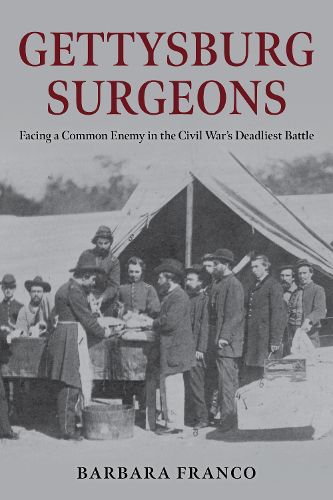Readings Newsletter
Become a Readings Member to make your shopping experience even easier.
Sign in or sign up for free!
You’re not far away from qualifying for FREE standard shipping within Australia
You’ve qualified for FREE standard shipping within Australia
The cart is loading…






The Battle of Gettysburg was one of the Civil War's turning points-and one of its bloodiest clashes of arms. At places now etched in history-Devil's Den, the Wheatfield, Cemetery Ridge-the carnage was horrific: some 50,000 men became casualties, about half of them wounded in need of medical care. During the battle's three days, and for months after, a thousand surgeons-military as well as civilian, southern but mostly northern-provided care to the wounded in conditions that beggared the imagination and stretched the limits of nineteenth-century medicine. Drawing on nearly a decade of research, historian Barbara Franco stitches together medical history, military history, and Civil War history to highlight the work of the surgeons of Gettysburg.
The medical staff of the Army of the Potomac and the Army of Northern Virginia had their hands-and medical tents and wagons-full even before the battle started. On the march for nearly a month, from central Virginia to southern Pennsylvania, soldiers fell out of the ranks daily with heat stroke, exhaustion, dehydration, malnutrition, injuries to feet and legs, wounds from skirmishes with the enemy, and a gut-wrenching array of illnesses, from dysentery to typhoid fever, whose causes were still poorly understood. Doctors and surgeons treated the sick and hurt while on the move themselves, working around the clock to keep the armies in fighting condition.
Once the shooting started on the morning of July 1, 1863, the situation became chaotic as medical personnel hurried to Gettysburg, where the fallen littered fields, woods, and town and makeshift hospitals opened in churches, barns, and other buildings. As surgeons settled in overnight, so did the armies, who unleashed hell on each other on July 2 and July 3, culminating in the devastation of Pickett's Charge. Chaos became nightmare as the wounded flooded hospital tents and surgeons went about the grisly work of treating bloodied and mangled soldiers, triaging patients, amputating limbs, and performing a narrow range of other surgeries, such as trephination of the skull. Surgeons worked in primitive field conditions with little rest or sleep while the battle still raged around them, the wounded groaned and cried, and gruesome scenes unfolded by the minute. Ether and chloroform were available for anesthesia, and morphine for pain, but the era did not yet have antibiotics or an understanding of germs, hygiene, and the need for sterile equipment. The work of surgeons continued long after the two armies left. A massive hospital camp was established, and thousands of Union and Confederate soldiers were treated until the facility finally closed the following November.
$9.00 standard shipping within Australia
FREE standard shipping within Australia for orders over $100.00
Express & International shipping calculated at checkout
Stock availability can be subject to change without notice. We recommend calling the shop or contacting our online team to check availability of low stock items. Please see our Shopping Online page for more details.
The Battle of Gettysburg was one of the Civil War's turning points-and one of its bloodiest clashes of arms. At places now etched in history-Devil's Den, the Wheatfield, Cemetery Ridge-the carnage was horrific: some 50,000 men became casualties, about half of them wounded in need of medical care. During the battle's three days, and for months after, a thousand surgeons-military as well as civilian, southern but mostly northern-provided care to the wounded in conditions that beggared the imagination and stretched the limits of nineteenth-century medicine. Drawing on nearly a decade of research, historian Barbara Franco stitches together medical history, military history, and Civil War history to highlight the work of the surgeons of Gettysburg.
The medical staff of the Army of the Potomac and the Army of Northern Virginia had their hands-and medical tents and wagons-full even before the battle started. On the march for nearly a month, from central Virginia to southern Pennsylvania, soldiers fell out of the ranks daily with heat stroke, exhaustion, dehydration, malnutrition, injuries to feet and legs, wounds from skirmishes with the enemy, and a gut-wrenching array of illnesses, from dysentery to typhoid fever, whose causes were still poorly understood. Doctors and surgeons treated the sick and hurt while on the move themselves, working around the clock to keep the armies in fighting condition.
Once the shooting started on the morning of July 1, 1863, the situation became chaotic as medical personnel hurried to Gettysburg, where the fallen littered fields, woods, and town and makeshift hospitals opened in churches, barns, and other buildings. As surgeons settled in overnight, so did the armies, who unleashed hell on each other on July 2 and July 3, culminating in the devastation of Pickett's Charge. Chaos became nightmare as the wounded flooded hospital tents and surgeons went about the grisly work of treating bloodied and mangled soldiers, triaging patients, amputating limbs, and performing a narrow range of other surgeries, such as trephination of the skull. Surgeons worked in primitive field conditions with little rest or sleep while the battle still raged around them, the wounded groaned and cried, and gruesome scenes unfolded by the minute. Ether and chloroform were available for anesthesia, and morphine for pain, but the era did not yet have antibiotics or an understanding of germs, hygiene, and the need for sterile equipment. The work of surgeons continued long after the two armies left. A massive hospital camp was established, and thousands of Union and Confederate soldiers were treated until the facility finally closed the following November.